Vout-Sikorsky OS2U "Kingfisher". "Kingfisher" from American battleships
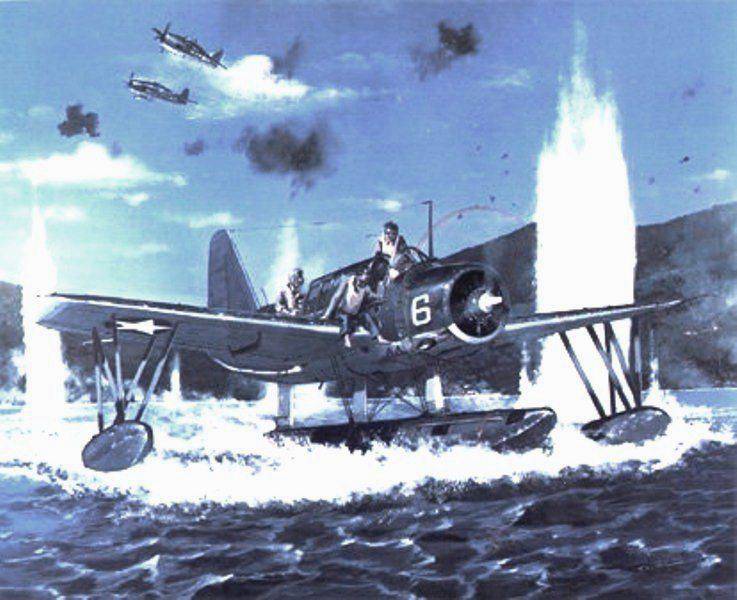
In the early thirties, the United States was armed with multi-purpose single-engine biplanes, which served as small scouts and patrol aircraft. On the navy such machines were the two-seater O3U "Corsair" firms "Vout-Sikorsky" and "Curtiss" SOS "Segall".
The wheeled “Corsairs” took off from conventional airfields, and the Curtiss plane, in addition to the ground, also had ship modifications. Some SOS biplanes were equipped with one central float and a pair of small underwing wings instead of a wheeled chassis. Float "Sigalli" based on the battleships and cruisers, taking off from a catapult. After landing on the water, the scouts climbed back aboard with a ship crane. There was also an option for aircraft carriers - SOS-3А with wheels and a brake hook.
Fully successful reconnaissance biplanes nevertheless rather quickly ceased to meet the requirements of seamen, and above all in range and altitude. Therefore, in the 1937 year, the US Navy announced a competition for a new ship seaplane spotter, which was supposed to change the SIG "Sigall". Requirements for the car did not differ originality: the crew had to consist of two people, the design of the aircraft should allow to change the float and wheeled chassis, and the wingspan did not exceed 10,97 m. Overall limitations dictated by the need to use on board the aircraft without folding consoles wing.
Three firms took part in the competition: Stirmen with an 85 model aircraft (XOSS-1), NAVE Aircraft Factory (an aviation branch of Navel Aircraft Factory) with the XOSN-1 project and Vout-Sikorsky with its XOS2U- 1 (model 310). The aircraft of the first two firms were quite traditional biplanes on a float landing gear (one central and a pair of underwing floats), which made it possible to replace it with a wheeled float). The power plant was also the same and consisted of the Pratt & Whitney aircraft engine R-1340-36 600 hp X
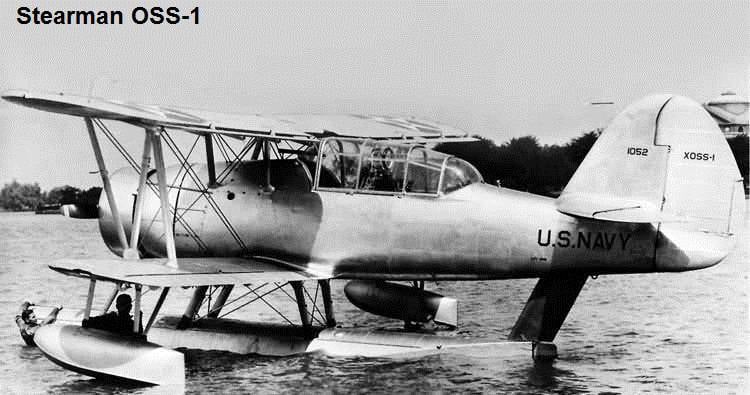
Designers "Vout-Sikorsky", headed by R. B. Beselom, approached the solution of the problem completely different. For Vout-Sikorsky, this competition was a chance to return to the ship reconnaissance market, for a good fifteen years this company was a monopolist of this type of aircraft of the US Navy, and only in 1935 year did this market lose to Curtissian Sigallu. Therefore, it was initially decided to create a car obviously more progressive than the competition. The designers decided to use the monoplane scheme, which allowed to improve the flight characteristics.
With the Pratt-Whitney nine-cylinder air-cooled R-985-4 “Wosp Junior” engine with 450 horsepower and the two-bladed propeller aircraft had a fully all-metal structure with a trapezoidal wing, with rounded tips. Only the rudders and part of the wing for the main spar had a linen trim. It should be noted that in the manufacture of the airframe, spot welding was widely used. The pilot and the observer were sitting behind each other, each in his cabin, separated by a fuel tank. The crew got to their workplaces by shifting the moving sections of the lanterns. The shooter opened the flashlight and when he was preparing for battle, freeing his Colt-Browning machinegun of 7,62 caliber mm. From the same barrel, shooting through the screw, the pilot could also fire. For a pair of small bombs for 45 kg mounted holders under the wing.
From the very beginning of the design, the aircraft was conceived in two versions - wheeled and float. The central float with redan was attached to the fuselage on two racks with braces, and a pair of winged floats - with special struts docked to the lower edge of the wing. Such a scheme with one central float (as in the previous SOS biplanes) was most convenient when launching an aircraft from a catapult. By unscrewing the bolted connections, the floats could be dismantled and the tricycle landing gear was installed. A small tail wheel was attached under the keel, and two pyramid struts with the main wheels rested on the fuselage, using the power mountings of the central float. At the same time, the track turned out to be small, and in the future, when operating the wheel variant, sometimes there were problems when taxiing.
Experienced XOS2U-1 first took to the air precisely on a wheeled chassis, when in March 1938-th company chief pilot Paul Baker tore off the plane from the East Hatford airfield. Two months later, 19 May, Hosxnumxu-Xnumx took off already from the water on the floats. The tests were quite successful, and the aircraft showed good stability and control.
With the R-985-48 engine (the same 450 horsepower), the aircraft went into series, receiving the OS2U-1 index, and subsequently also the Kingfisher own name - Kingfisher. The serial OS2U-1 differed from the prototype, in addition to the motor, also with a new form of underwing floats and an additional third pillar mounting the central float to the fuselage.
In 1940, the company “Vout-Sikorsky” assembled 54 serial “Kisfisher”, the first of which was rolled out of the shops in April. The first in the fleet new scout got in the 1940-m battleships "Colorado" and "Mississippi". Soon OS2U-1 supplemented the armament of the battleships at the bases in Pearl Harbor and Alameda. In addition to the ships, the “Kingfisher” of the first version was also received by the naval base in Pensacola.
In 1941, a version of OS2U-2 appeared with updated equipment and an R-985-48 engine, hp 455 power. Of the 158 built OS2U-2 - 45 copies released in the float version, and the rest equipped with wheels (although all land vehicles, if necessary, could quickly turn into a hydroplane, having floats as a standard additional equipment). The 46 Kingfishers were received by sea pilots in Pensacola, and the 53 aircraft flew to a base in Florida, from where they performed patrol flights over the Gulf of Mexico.
In May 1941, Boone Gayton flew the next version of Kingfisher - OS2U-3. The Troika received an R-985-A-2 motor (or AN-8) horsepower 450, additional wing tanks and crew body armor weighing 85 kg. In 1941, Vout-Sikorsky produced 363 "twos" and "triples", and the next 638. At this, Kingfisher’s serial production at home factories was stopped, besides, the company urgently needed production facilities for the mass assembly of the very necessary fleet, the F4U Corsair fighter.
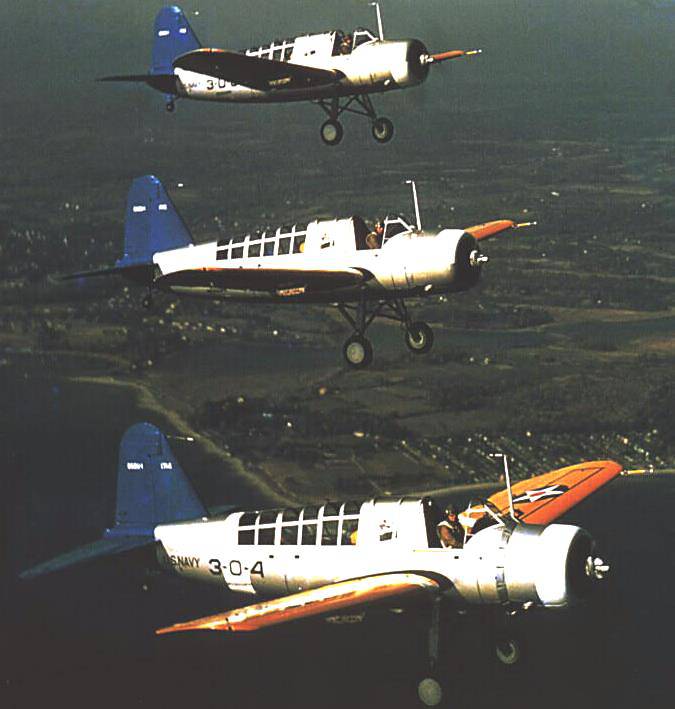
Most of the OS2U-3 was released in a land wheeled version and many of them fell into military service at bases in Norfolk, Jacksonville and Pensacola. Another 300 OS2U-3s were assembled under license from the Navil Aircraft Factory in Florida. These "Kingfisher" had their own OS2N-1 index and entered service with nine patrol squadrons in 1942. Before the United States entered World War II, almost all the battleships of the fleet had catapults with the Knngfishsra on the decks. The cruisers began to equip new scouts, although here the rearmament process was not so fast. In May 1940, the fleet management decided to equip six Fletcher class destroyers with a catapult aircraft. At the same time, one destroyer of the main caliber and one of the torpedo tubes had to be dismantled from the destroyers. Instead, on these ships a rotary catapult was mounted on the waist, while the length of the catapult did not provide 360 ° rotation, as a result of which the Kingfisher could only launch on the starboard side. Before the catapult, a storage facility for 4700 tons of aviation gasoline was equipped. Really aviation armament in 1942 was installed only on three destroyers: Pringle, Stevens and Halford. Pretty soon it became completely clear that due to the relatively small size of these warships, the operation of the Kingfisher on the Fletchers was difficult and troublesome, and this idea was abandoned.
Performing flights from battleships and cruisers during the war, the aircraft of the Vout-Sikorsky firm provided reconnaissance, fire adjustment, and also carried out rescue and connected operations. Despite the small bomb load, the Kingfisher was also involved in bombing. For example, 15 on July 1942 of a pair of OS2U from the VS-9 squadron of the Marine Corps Air Force, helped Unicol sentry to fire a German U-576 submarine off the coast of North Carolina. Another submarine under the symbol U-176 "Kingfisher" recorded 15 in his combat asset 1943 in May. On this day, a plane from the Kay West base successfully attacked a submarine from the Bahamas from the air with depth charges, which was finished off by a sea hunter who had come to the aid.
Float "Kingfishers" were involved in the search for sailors from sunken ships and pilots from aircraft shot down over the sea. Perhaps the most famous such rescue operation with the participation of Kingfisher was the rescue of the crew of Captain Eric Rickenbaner when his damaged “flying fortress” B-17 sat down on October 1942 on water in the Pacific Ocean. The pilots were searched for a long time, and only on November 11 the pilot of the Kingfisher from a base on the islands of Elpis noticed a rubber boat. Being driven near, the plane took on board five rescued pilots together with the commander of the crew. But with such a load, the Kingfisher could not tear himself away from the water, and the 40 float-saver flew miles to the nearest island, gliding along the waves like a glider. The next day, two more pilots with B-17 from above found another plane, and this pair was also taken out by the Kingfisher.
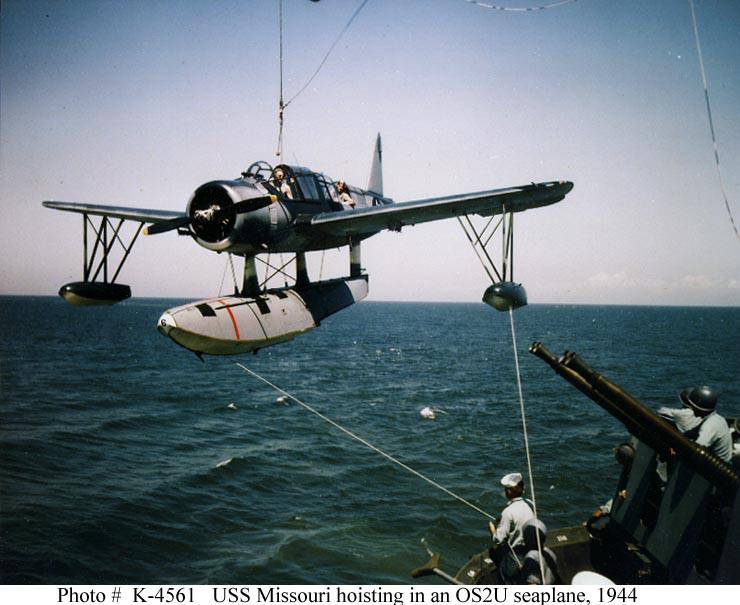
Combat flights during the war were made by the English "Kingfisher". The Royal Fleet of Great Britain, under Lend-Lease, received OS2U-3 on floats and wheels. The aircraft armed several squadrons, which were based in England, South Africa and Trinidad. The tasks of the English OS2U-3 crews were very different - the training of sea pilots and observers, patrol flights and the search for submarines.
Perhaps the most intense was the service of the Kingfisher pilots from squadron No. 703. The aircraft of this part were based on the auxiliary cruisers "Canton", "Silicia" and "Corfu", taking off from a catapult. The ships were converted and well-armed former merchant ships. Carrying patrol in the South Atlantic and Indian Ocean, cruisers escorted convoys, providing intelligence and search for German submarines. To perform these tasks, the Kingfishers constantly launched from shipboard catapults, completing a large number of combat missions. The most active were pilots from the cruisers “Silicia” and “Corfu”, who made 1942 th to March 1944 th 200 and 142 from May, respectively.
On their wings, the Kingfishers carried not only American white stars and tricolor English circles, but also insignia of several Latin American countries. Most of all "Kingfishers" got Chile - 15 machines. Nine aircraft were sold to Argentina, six scouts were transferred to Mexico and Uruguay, and three went to the Dominican Republic. Australia became another master of the float scouts, but the planes were inherited from Holland. The Dutch government ordered the Vout-Sikorsky firm 24 OS2U-3, requiring float scouts for their colonies in Dutch India. However, when ships with planes sailed in the Indian Ocean, the Japanese had already begun to occupy Dutch territory island by island. The ships had to moor in Australia, and thus 18 OS2U-3 went to the air forces of the Green Continent, becoming part of the 3 training unit and squadron No. 107. The main task of the Australian Kingfisher was the search for Japanese submarines off the east coast of the country. These planes could carry a pair of depth bombs on 113 kg (instead of 45 kg) under the wings, for which the Australians had to remove the crew’s armor protection.
Nine Australian Kingfishers survived the war, and one of them participated in an Antarctic expedition aboard the Watt Irp in 1947. Pilot Gray flew his brightly yellow plane over the course of the cruise for more than 55 hours, conducting ice reconnaissance.
They flew "Kingfisher" in the Soviet sky. After the landing of the Allies in Italy, they got a significant part of the surviving Italian fleet. In accordance with the agreements, the Soviet Union was to receive its share in the division. But the Allies refused to immediately transfer part of the Italian fleet to the USSR, promising in exchange to temporarily isolate several ships from their fleets. Together with the old English battleship Royal Soverin, eight destroyers and four submarines, the Northern Fleet also received the American cruiser Milwaukee. 24 August 1944, the cruiser entered the Kola Bay, receiving a new name - "Murmansk". The Soviet crew embarked on the development of foreign weapons, among which was a pair of Kingfisher OS2U-3. Having painted over the white American stars with red paint, our pilots made several training sorties on the float scouts, including from the catapult. Until the end of the war, "Murmansk" was listed in the combat fleet of the Northern Fleet, and in 1947-m was returned back to the United States.
By the end of the war, the type of float ship scout with an ejection launch was already considered obsolete. In addition, Kingfisher was inferior in its characteristics to its foreign opponents. On the kriegsmarine ships, the same service was carried by the double-float “Arado” Ag-196, which with a maximum speed of 310 km / h overtook the Kingfisher by almost 50 km / h. And the domestic KOR-2 surpassed the American aircraft even more.
It is worth noting that in 1942, the designers of the Vout-Sikorsky firm were going to improve the performance of the aircraft by installing a more powerful engine and a modified wing, but it didn’t come to flight. Nevertheless, the Kingfisher has served in the US Navy until the end of the war, remaining a full-fledged fighting vehicle. Unlike their overseas ally, the British abandoned the use of these aircraft on ships in the spring of 1944. But the longest on combat duty remained these machines, delivered to South America. Here, the Kingfishers, before 60, carried patrol service over the ocean.
Kingfishers turned out to be one of the few types of American aircraft that took part in hostilities from the first to the last day of the war. Moreover, these machines reached the end of the war in the same form, in which they met, - the aircraft was not subjected to any serious modernization. Despite modest characteristics and weak weapons, the scout of Vout-Sikorsky firm honestly went through the whole war, and contributed to the victory. After the war in the United States, few OS2U-3 and OS2N-1 flew in training units. The last of them were written off in 1947. Until today, four copies of this car have been preserved in American museums. Three of them are on the decks of the Alabama, Massachusetts, and North Carolina battleships and museums. And the fourth in the Museum of Naval Aviation in Pensacola.
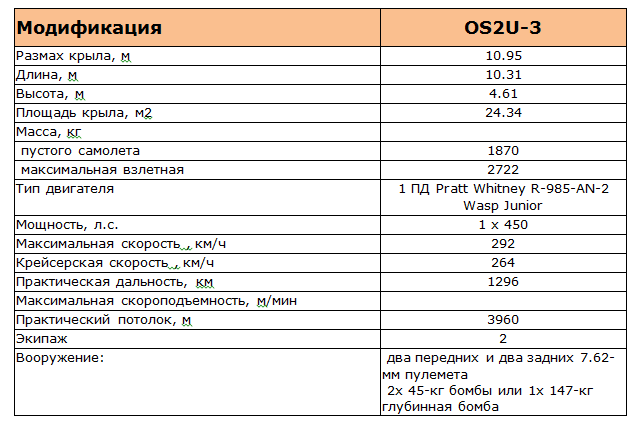
Sources:
Kotelnikov V. Vout-Sikorsky OS2U "Kingfisher" // World of Aviation. 1993. No.2. C. 16-20.
Chechin A. Vout-Sikorsky "Kingfisher". “Opponent found!” // Model-designer. 1999. No.4. C.21-26.
Kolov S. "Kingfisher" for the fleet // Wings of the Motherland. 2001. No.11. C. 11-13.
Kotelnikov V. Planes of the Second World War. Seaplanes // Model-designer. Special edition. 2003. No.2. C. 63-64.
Haruk A. Vout-Sikorsky OS2U "Kingfisher" // All seaplanes of World War II. M .: Yauza, 2014. C. 216-223.
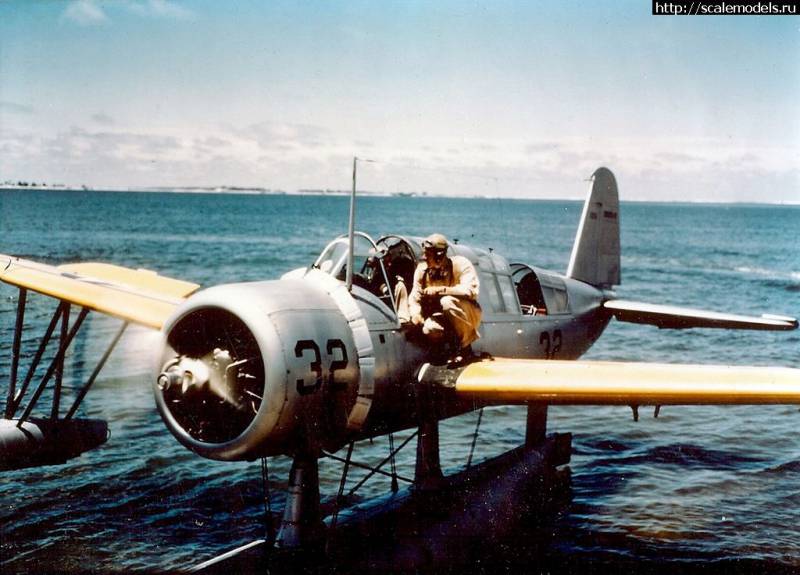
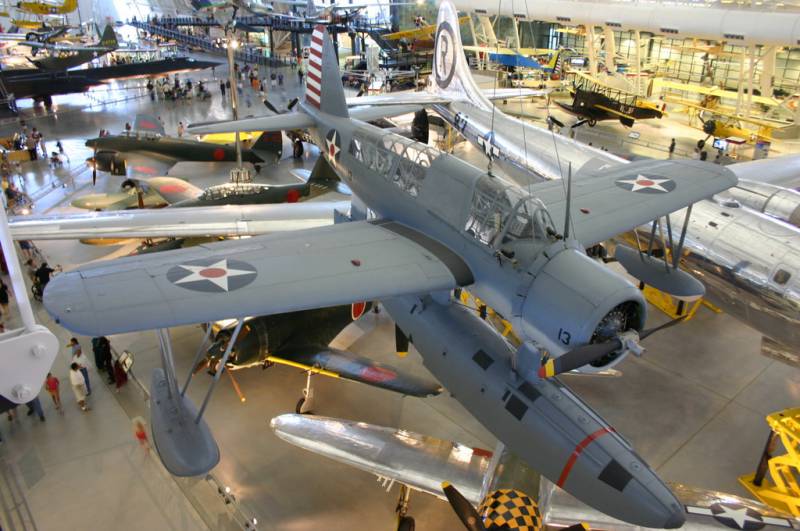
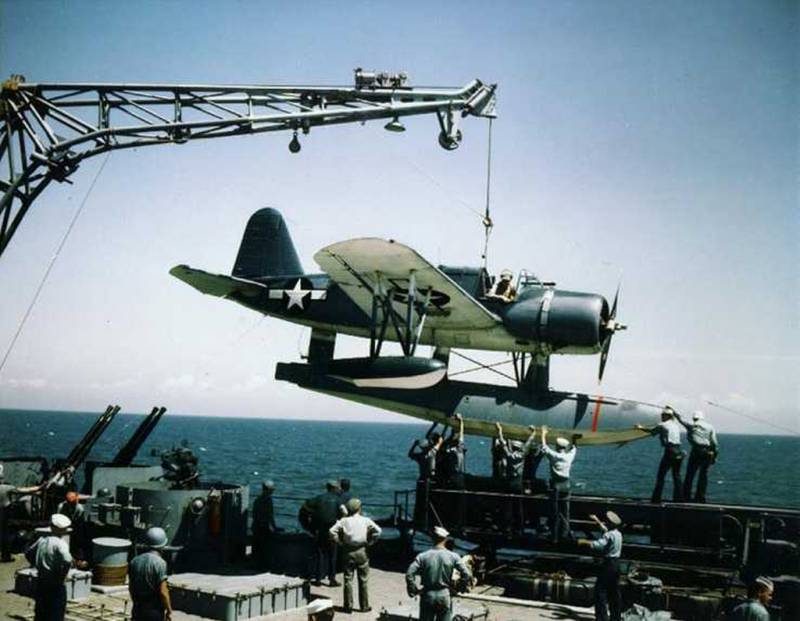
Information